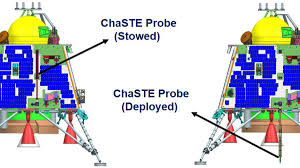Chandrayaan-3 ChaSTE:

Chandrayaan-3’s Surface Thermophysical Experiment (ChaSTE) became the first instrument to measure in situ temperatures near the moon’s south pole.
- It successfully penetrated lunar soil and deployed a thermal probe, achieving what two previous missions—ESA’s Philae (2014) and NASA’s InSight HP3 (2018)—could not.
- This experiment provided crucial data on lunar surface temperatures, strengthening evidence of water ice deposits.
- ChaSTE’s thermal probe was integrated into the Vikram lander of Chandrayaan-3, which landed on August 23, 2023.
- The probe is equipped with 10 temperature sensors placed 1 cm apart along its length, near the nose-tip.
- It uses a rotation-based deployment mechanism instead of a hammering device, which played a crucial role in its success.
- The motor rotates, pushing the probe downward until the tip touches the Moon’s surface.
- As the probe continues to penetrate deeper, the increasing resistance from the lunar soil helps determine how far it has descended.
- ChaSTE successfully reached a depth of 10 cm in the Moon’s regolith, where it continuously monitored temperature variations until September 2, 2023.
- The final temperature readings from the deep lunar soil confirmed thermal properties essential for lunar exploration.




